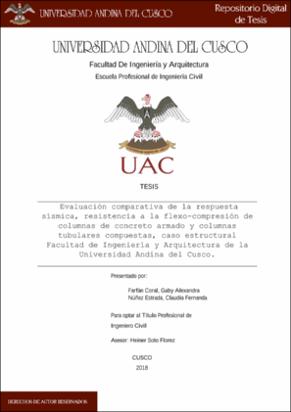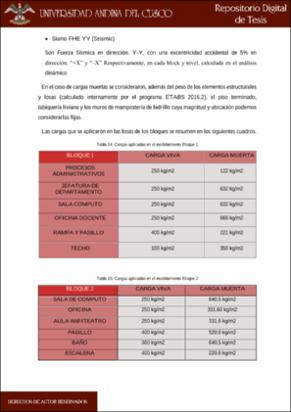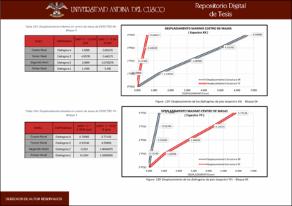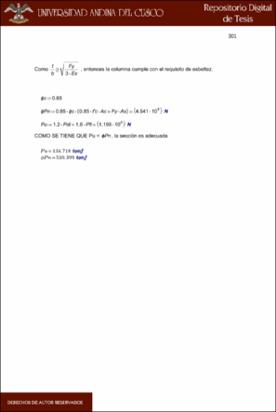| dc.contributor.advisor | Soto Florez, Heiner | |
| dc.contributor.author | Farfán Coral, Gaby Alexandra | |
| dc.contributor.author | Núñez Estrada, Claudia Fernanda | |
| dc.date.accessioned | 2019-02-18T17:09:21Z | |
| dc.date.available | 2019-02-18T17:09:21Z | |
| dc.date.issued | 2018-11-16 | |
| dc.identifier.uri | https://hdl.handle.net/20.500.12557/2221 | |
| dc.description.abstract | En la presente investigación se realizó el estudio comparativo entre un sistema estructural
en concreto de la edificación existente, Facultad de Ingeniería y Arquitectura de la
Universidad Andina del Cusco y la misma edificación en un sistema estructural en acero,
compuesto por columnas tubulares compuestas, vigas I y Losas tipo deck. Para poder realizar
esta comparación realizamos dos modelamientos, el primero de la estructura existente en
concreto armado y el segundo de la misma estructura pero con columnas tubulares compuestas
y elementos de acero. La estructura existente se divide en 6 bloques cada uno de 5 niveles.
Después de un análisis de la estructura actual con ayuda del software Etabs y las Normas
Técnicas Peruanas (NTP E 0.30 2016, NTP 0.60, NTP 0.20 y NTP 0.90. Se concluyó que 4
bloques tenían irregularidades y el bloque 6 tenía unas derivas de hasta 0.011 m/m lo cual es
mayor a lo permitido en norma (0.007 m/m). Para poder realizar una comparación trabajamos
con los mismos bloques y mantuvimos las irregularidades pero se diseñó en acero de tal
manera que se redujo las derivas en el bloque 6 en acero a 0.007 m/m en un sistema estructural
de acero.
Para realizar el modelamiento de la estructura con elementos compuestos y de acero fue
necesario realizar cálculos previos, como el predimensionamiento y comprobación de
resistencias a las cargas a las que iba a ser sometida la edificación. Al ser el acero un elemento
prefabricado, se utilizaron medidas de secciones comerciales que cumplían con las
dimensiones obtenidas en los cálculos. Teniendo estos valores se pudo proceder al
modelamiento.
Finalmente se realizó la comparación de los sistemas estructurales, se concluyó en que el
sistema estructural de acero tiene menos peso, tiene secciones de elementos estructurales más
pequeñas, las estructuras metálicas tiene desplazamientos mayores y por lo tanto las derivas
son mayores pero cumplían las derivas máximas indicados en la NTP E.030. La resistencia a
flexo-compresión en las secciones tubulares compuestas a pesar de tener secciones más
pequeñas siguió cumpliendo las solicitaciones de la edificación. Además se observó que en
partidas como losas, columnas y vigas existe ahorro en cuanto uso de materiales, debido a la
a que se obvian partidas como el encofrado. | es_PE |
| dc.description.abstract | In this research, a comparative study was made between a structural concrete system of the
existing building, Faculty of Engineering and Architecture of the Universidad Andina of
Cusco and the same building in a structural steel system, composed of composite tubular
columns, beams I and deck slabs. In order to make this comparison we made two models, the
first one was of the existing structure in reinforced concrete and the otherone of the same
structure but with composite tubular sections and steel. The existing structure is divided into
6 blocks each of 5 levels. After an analysis of the current structure with the help of the Etabs
software and the Peruvian Technical Standards (NTP E 0.30 2016, NTP 0.60, NTP 0.20 and
NTP 0.90) It was concluded that 4 blocks have irregularities and block 6 have drifts greater
than the allowed (0.011 m / m). In order to make a comparison we worked with the same
blocks and maintained the irregularities but the steel designed reduced the drift in block 6 to
0.007 in a steel structural section.
To carry out the modeling of the structure with steel and composite elements, it was
necessary to carry out previous calculations, such as the pre-dimensioning and checking of
resistances to the loads to which the building was been subjected. As the steel was a
prefabricated element, measurements of commercial sections that met the dimensions
obtained in the calculations had used. Having these values, it was possible to modeling.
Finally, the comparison of the structural systems had made, it had concluded that the
structural steel system is lighter, it has smaller sections of structural elements, the metallic
structures have greater displacements and therefore the drifts are bigger but they fulfilled the
maximum drifts indicated in the NTP E.030. The resistance to flexo-compression in the
composite tubular sections despite having smaller sections continued to meet the demands of
the building. In addition, it had observed that in items such as slabs and columns there is
savings in terms of labor and material use, due to the speed at which the construction process
will been executed and that items such as formwork are obviated. | en_US |
| dc.description.uri | Tesis | es_PE |
| dc.format | application/pdf | es_PE |
| dc.language.iso | spa | es_PE |
| dc.publisher | Universidad Andina del Cusco | es_PE |
| dc.rights | info:eu-repo/semantics/openAccess | es_PE |
| dc.rights.uri | https://creativecommons.org/licenses/by-nc-nd/2.5/pe/ | es_PE |
| dc.source | Universidad Andina del Cusco | es_PE |
| dc.source | Repositorio Institucional - UAC | es_PE |
| dc.subject | Acero | es_PE |
| dc.subject | Columnas tubulares | es_PE |
| dc.subject | Propiedades | es_PE |
| dc.subject | Diseño | es_PE |
| dc.subject | Losa | es_PE |
| dc.subject | Derivadas máximas | es_PE |
| dc.title | Evaluación comparativa de la respuesta sísmica, resistencia a la flexo-compresión de columnas de concreto armado y columnas tubulares compuestas, caso estructural Facultad de Ingeniería y Arquitectura de la Universidad Andina del Cusco. | es_PE |
| dc.type | info:eu-repo/semantics/bachelorThesis | es_PE |
| thesis.degree.name | Ingeniero Civil | es_PE |
| thesis.degree.grantor | Universidad Andina del Cusco. Facultad de Ingeniería y Arquitectura | es_PE |
| thesis.degree.level | Titulo Profesional | es_PE |
| thesis.degree.discipline | Ingeniería Civil | es_PE |





